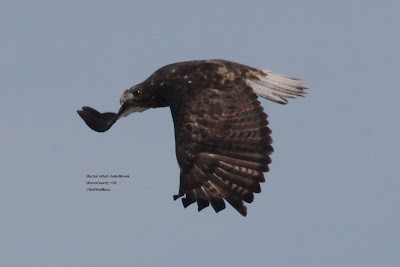More Canon City sightings of Harlan's Hawk(s)

Three days ago (Oct 30) I spotted the hawk in the top pic at dusk. It is a dark morph Harlan's Hawk-it is all dark except for tail (only underside visible) that clearly has a light/grayish undertail (at least the distal portion visible in pic), with wingtips a little shorter than tail (a characteristic of Harlan's per Hawks of W. North America ). I suspect this is the dark morph Harlan's I have spotted a couple of times in Canon City in the past 2 weeks. Since I knew at least one Harlan's was still around, the next day I went looking for one and the bird in the bottom pic flushed from it's perch and began circling higher and higher so I barely got this one reasonable pic before it took off. There is a 'white swath' (description in Hawks of W. North America ) under it's eye visible when photo enlarged. White on neck not visible in this photo or in my brief views in the field (so could be an integrade?). This bird looks to me like a juvenile i...





